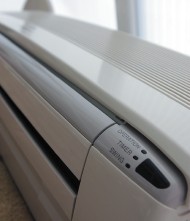The flexibility and energy efficiency of VRF air conditioning

A wide range of indoor units can be teamed up in VRF air-conditioning systems — such as the floor and wall units shown here.
VRF air-conditioning systems owe their growing popularity to their ability to meet a wide range of requirements, as Tony Nielsen explains.The primary function of all air-conditioning systems is to provide thermal comfort for building occupants. There is a wide range of system types available, staring with the basic window-fitted unit through to the very latest VRF (variable refrigerant flow) equipment. Deciding which system best suits the application will depend on several variables. For example, in a modern, design-conscious office the aesthetic requirements of the client may prove of greater importance than the number of control options they provide. While a client looking for the best life-cycle cost will need to balance capital cost with long-term operating costs, efficiency and predicted maintenance costs.
Extremely popular Currently, VRF systems are proving extremely popular in satisfying a number of these variables. The flexibility of mixing a range of indoor models (e.g. floor, wall, ceiling-mounted and ducted units) with the correctly rated outdoor unit means that VRF is appropriate for a range of building types. Compared to traditional air conditioning systems, VRF is easier to design and offers space-saving features. Its modular format lends itself to phased installations, and a range of system controller solutions allows the end-user to select the controller that best suits them. VRF systems provide cooling and heating using refrigerant (R407C or R410A) as the working fluid. There are two basic types of VRF system — cooling/heating-only and energy-recovery. Cooling/heating-only can provide just cooling or, with the incorporation of a heat pump, cooling or heating to the space — but not both at the same time. The energy-recovery system, can provide cooling and heating simultaneously, to different parts of the building. This feature has the potential to deliver maximum energy savings. Further, a heat-recovery system can transfer the heat extracted from those spaces requiring cooling to areas demanding heating — resulting in extremely high primary-energy ratios and low operating costs. Outdoor units are available with different cooling and heating capacities to suit the application. A host of controller options is available, from simple wireless controllers to powerful PC software packages. Finally, all the units are linked using transmission cable, providing a fully networked air-conditioning system.
Basic principle of operation: When in the cooling mode, indoor units are supplied with liquid refrigerant. The amount of refrigerant flowing through the unit is controlled via an electronic expansion valve located inside the unit. When the refrigerant enters the coil it undergoes a phase change (evaporation) that extracts heat from the space, thereby cooling the room. The heat extracted from the space is exhausted to ambient air. When in the heating mode, indoor units are supplied with hot gas refrigerant. Again, the amount of hot gas flowing through the unit is controlled via the same electronic expansion valve. As with the liquid refrigerant, the hot gas undergoes a phase change (condensation), which releases heat energy into the space. As the system name suggests, the outdoor unit must have the capability to deliver a ‘variable flow’ of refrigerant dependent on the demand of the indoor units. VRF outdoor units, for example, can meet this requirement by using multiple compressors of different capacities. Alternatively,inverter technology can be used.
Case Study Sopwell House Hotel in St Albans is renowned for its high-status guests, England’s cricket and football teams being examples. Its history goes back to the 17th century when a Duchess took refuge during the great plague of 1664. Over the centuries the building has evolved as different families took occupation, including Prince Louis of Battenburg (Lord Mountbatten’s father), to become a 4-star hotel. The latest phase of improvements has seen extensive refurbishment of its 42 bedrooms including the installation of a Fujitsu VRF (variable refrigerant flow) system supplied by FM Air Conditioning. The work, which was carried out by IMA Cooling Systems, had originally called for a combination of cooling-only split air conditioners and radiator systems. However, the installer pointed out that with discrete heating and cooling systems there is a possibility that the two can be left running at the same time. With an energy-recovery VRF system, however, simultaneous heating and cooling is available delivering conditioned air to the guests’ requirements. VRF also provided the added bonus of running multiple indoor units from a single condenser without compromising guest comfort. Sopwell House Hotel now ensures that its guests stay in comfort by utilising the very latest Japanese technology — variable refrigerant flow. VRF provides thermal comfort for building occupants as well as delivering the advantages of flexible design, ease of installation and energy efficiency, which in turn benefits the environment.
Tony Nielsen is air-conditioning product manager for Fujitsu General (UK) Co. Ltd, Unit 150, Centennial Park, Centennial Avenue, Elstree, Herts, WD6 3SG.
Related links:
Related articles:


